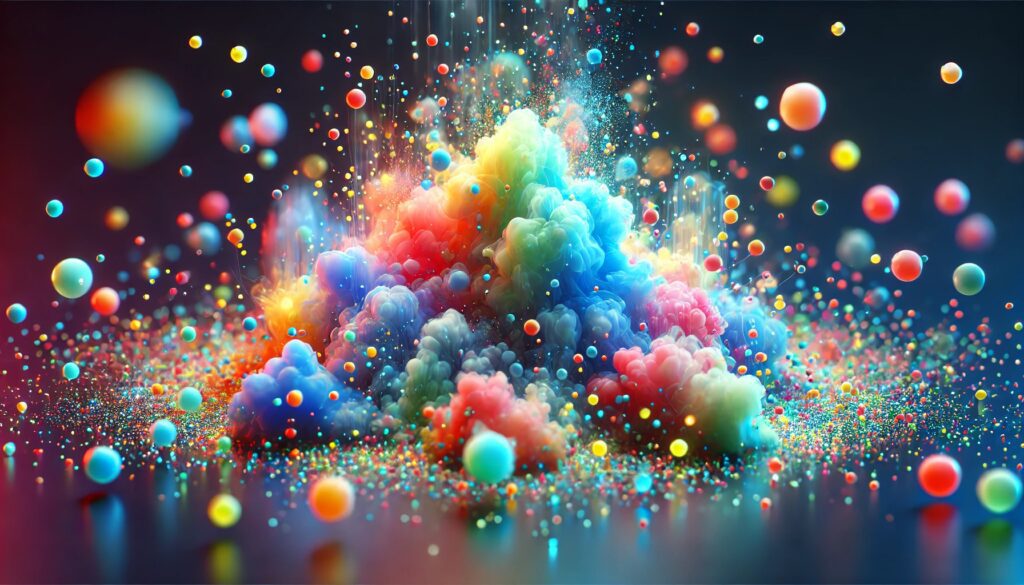
The Evolution of Neural Rendering: A Quick Overview
Neural rendering is taking the world of computer graphics by storm. Over the last few years, it has transformed from a niche topic in AI to a revolutionary technology that’s changing the way we perceive 3D environments.
But it didn’t start this way.
Earlier rendering techniques were built on traditional mathematical models—complex, rigid, and computationally expensive. Neural Radiance Fields (NeRFs) stepped in and offered something fresh: the ability to generate highly detailed 3D scenes from just a few images.
But now, there’s an even newer player in town—3D Gaussian Splatting. It promises to make neural rendering faster and more lifelike than ever before.
What Are NeRFs, and Why Are They Important?
To understand why 3D Gaussian Splatting is so revolutionary, we first need to dive into what NeRFs are. NeRF stands for Neural Radiance Fields. In essence, a NeRF is a neural network that learns to generate 3D views of a scene based on a set of 2D images. It works by encoding the scene into a high-dimensional space and then reconstructing it with striking realism.
NeRFs have been used in augmented reality and virtual worlds, giving creators new ways to build 3D spaces without manual 3D modeling. But as with any new technology, NeRFs have limitations, especially when it comes to real-time applications. This is where the magic of 3D Gaussian Splatting begins.
Enter 3D Gaussian Splatting: A Game Changer
So, what exactly is 3D Gaussian Splatting? If you think it sounds technical, you’re right. But at its core, it’s a method that takes the volumetric rendering concept of NeRFs and optimizes it for speed. Instead of trying to reconstruct an entire scene pixel by pixel, 3D Gaussian Splatting models objects in the scene as smooth, overlapping “splats” (or blobs) of Gaussian functions. These splats represent how light and color should be distributed in space, creating a visual result that’s both highly accurate and quick to compute.
This method is groundbreaking because it solves one of the biggest problems with NeRFs: rendering time. NeRFs are incredibly detailed, but they can take hours or even days to render a scene. With 3D Gaussian Splatting, we’re talking about rendering speeds in real-time. This isn’t just an improvement—it’s a leap forward.
How 3D Gaussian Splatting Works in Neural Rendering
To understand why 3D Gaussian Splatting is so fast, let’s peek under the hood. Traditional NeRFs rely on sampling the environment and reconstructing the scene using dense neural networks.
This requires an immense amount of computation. By contrast, 3D Gaussian Splatting simplifies this by reducing the need for such high-level sampling. Instead, it uses probability functions (the Gaussians) to represent light distribution across the scene. This allows for much more efficient calculations.
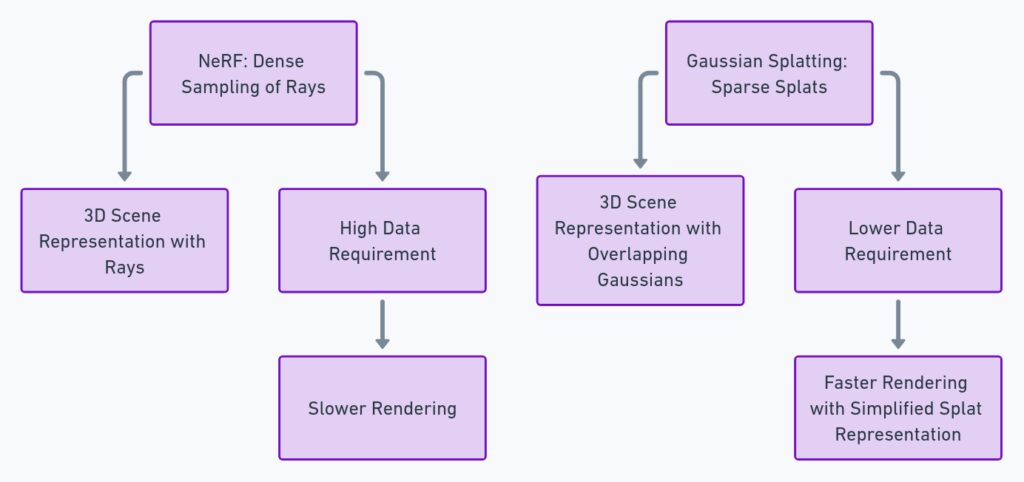
The beauty of this approach is that it still retains the photorealistic quality of NeRFs but without the long processing times. It works especially well in real-time environments like games or virtual reality, where speed is crucial. You can now explore richly detailed virtual worlds without waiting hours for rendering.
Speed vs. Quality: Where NeRFs Fall Short
While NeRFs brought incredible visual detail to neural rendering, they also introduced a bottleneck—speed. To produce such high-quality, lifelike scenes, NeRFs require a lot of time and computational power. This makes them impractical for real-time applications like interactive games or live virtual tours. For example, rendering a scene with NeRFs for a single view might take minutes or even longer, which just isn’t feasible when you need smooth, responsive environments.
In contrast, 3D Gaussian Splatting balances both speed and quality by avoiding some of the computational burdens NeRFs face. While it may not always achieve the pixel-perfect realism of NeRFs in every scenario, the difference is minimal—especially when the benefits of real-time rendering come into play.
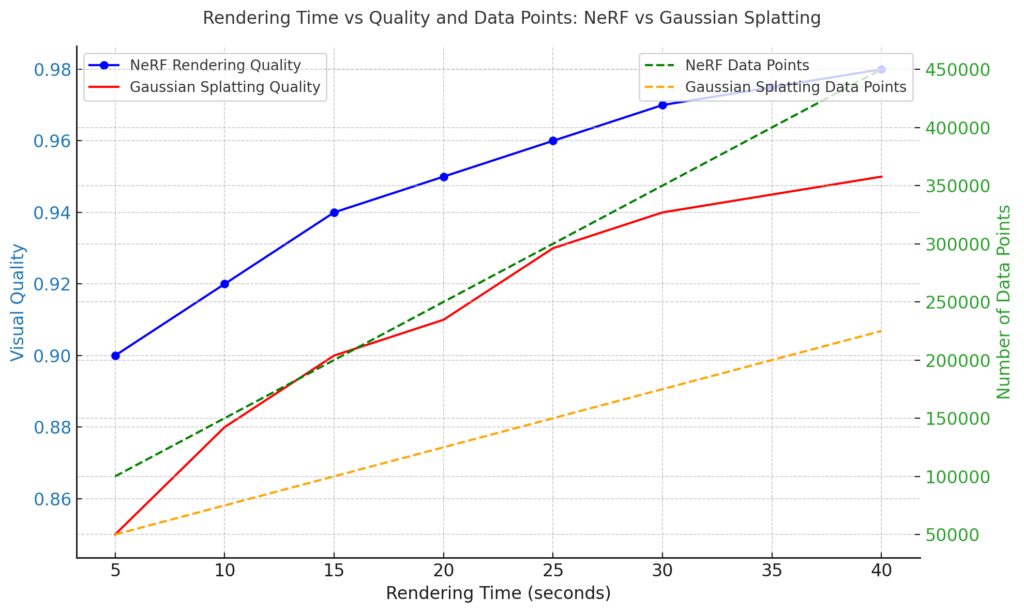
This is why many developers and artists are now looking beyond NeRFs and turning to Gaussian Splatting as the future of neural rendering.
Why 3D Gaussian Splatting Is Faster and More Efficient
The efficiency of 3D Gaussian Splatting comes from how it manages data. NeRFs use dense grids to represent light and color at every point in a scene. While detailed, this process is slow and bloated with unnecessary information. Gaussian splats, however, are sparse representations. Instead of covering every point, splats focus only on areas where visual information is critical.
By cutting down on the number of data points, 3D Gaussian Splatting can render a scene in real-time without losing significant quality. This makes it an ideal solution for fast-paced, immersive applications like augmented reality and real-time 3D gaming, where you need both speed and accuracy.
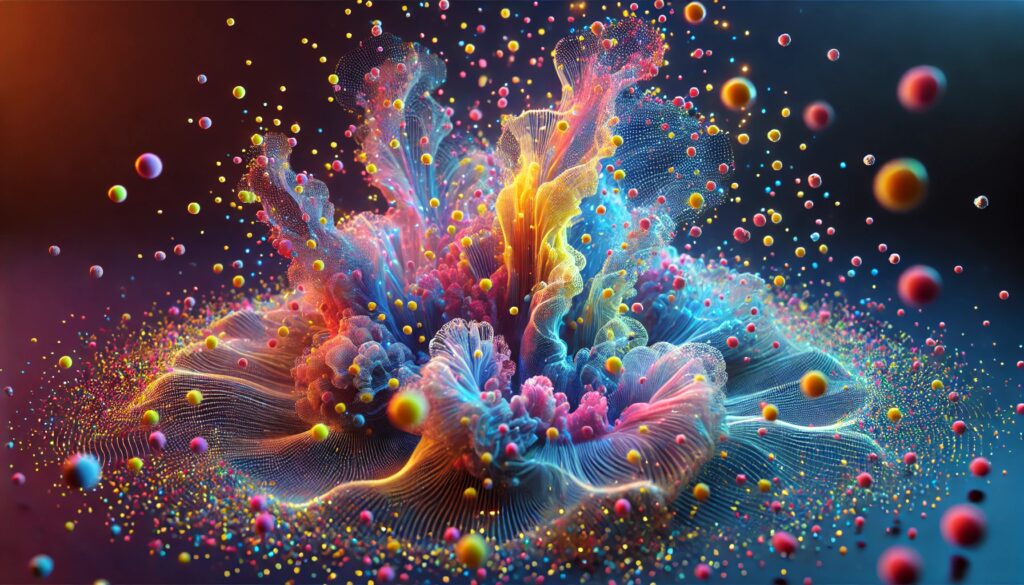
Imagine walking through a virtual museum or playing a game where the environment responds to you instantly. Gaussian Splatting makes this possible by processing information at a fraction of the time required by NeRFs.
The Impact on Real-Time Graphics and Animation
One of the most exciting aspects of 3D Gaussian Splatting is its ability to revolutionize real-time graphics and animation. Traditionally, 3D modeling and rendering were time-consuming, which limited how quickly a scene could be updated or animated. NeRFs made significant progress in improving the realism of scenes, but their rendering speed still left much to be desired.
Now, with Gaussian Splatting, artists and developers can achieve both high fidelity and instant feedback.
This is especially crucial in industries like film and animation, where realism is key but production timelines are tight. In applications like virtual reality (VR) and augmented reality (AR), this speed ensures that users can experience seamless environments without the lag that often breaks immersion. By using Gaussian Splatting, developers can create real-time updates to virtual worlds with far less computational strain.
3D Gaussian Splatting and VR: What’s the Connection?
If you’ve ever used a VR headset, you know how important smooth rendering is to the experience. Lag, choppy visuals, or poorly rendered objects can make even the best virtual environments feel disorienting.
NeRFs offer visual realism, but they often can’t keep up with the fast-paced movement in VR. This is where 3D Gaussian Splatting shines. Because it can handle complex scenes in real-time, it’s poised to elevate the VR experience to new heights.
By reducing the processing time needed for each frame, Gaussian Splatting ensures that virtual environments feel smooth and responsive. Imagine being able to explore a photorealistic cityscape or navigate through a detailed simulation without any noticeable lag. The promise of 3D Gaussian Splatting is to make these experiences as fluid and engaging as possible, enhancing everything from gaming to virtual tourism.
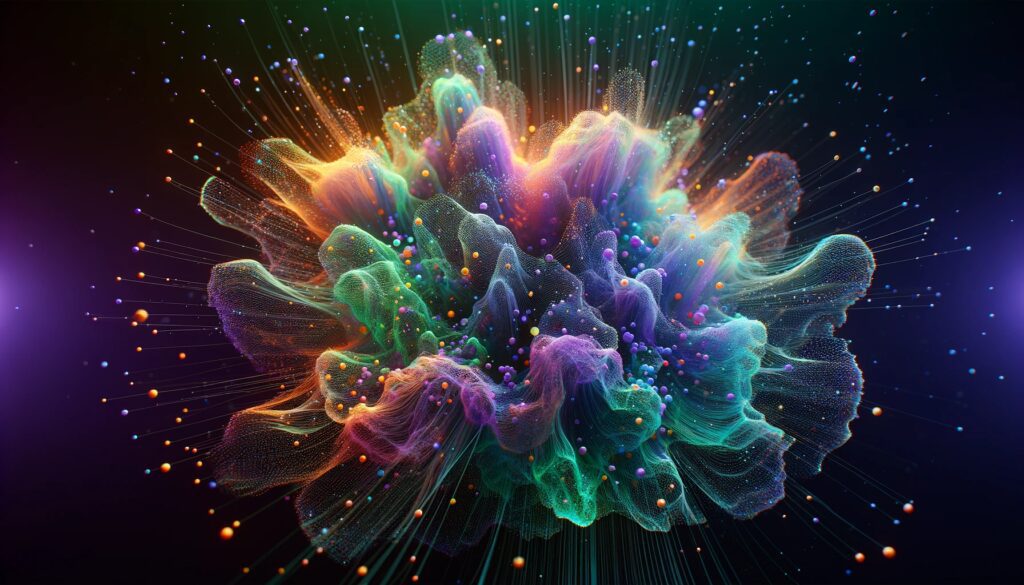
From Theory to Practice: Applications in Gaming
Gaming is another area where 3D Gaussian Splatting is likely to have a huge impact. Game developers are constantly pushing the boundaries of realism, but until now, they’ve been limited by the trade-off between detail and performance. With Gaussian Splatting, games can feature richer, more immersive worlds that are not only visually stunning but also responsive in real-time.
For example, imagine a game where environments can dynamically change based on the player’s actions, all without causing a drop in frame rates. Gaussian Splatting’s efficiency allows for highly detailed, interactive environments that don’t bog down gameplay. This could be a game-changer for open-world games, where the ability to render large, detailed environments quickly is crucial.
In fact, gaming engines are already experimenting with techniques similar to Gaussian Splatting to improve rendering times while maintaining high levels of realism. Developers who embrace this technology will have the advantage of creating games that look better and run smoother than ever before.
Overcoming the Limitations of Traditional 3D Models
For years, 3D modeling has been the standard for creating virtual environments, but it comes with its own set of limitations. Polygon-based models are labor-intensive to create, requiring artists to painstakingly craft every detail. This process is not only time-consuming but also restricts the level of detail that can be achieved, especially in dynamic or large-scale environments.
With NeRFs and now 3D Gaussian Splatting, those limitations are being challenged. Rather than relying on polygons, Gaussian Splatting works with volumetric data, which means that complex shapes and fine details can be represented without having to manually model them.
This offers a more flexible and scalable approach to 3D rendering, allowing for greater creativity and efficiency. As a result, artists and developers can focus on the creative aspects of their projects, leaving the technical heavy lifting to the AI.
Enhancing Virtual Worlds with Immersive Detail
One of the biggest benefits of Gaussian Splatting is how it enhances virtual environments with an unprecedented level of detail. By using probabilistic splats to represent light, shadow, and texture, this method creates visuals that feel more natural and immersive. The soft, blended edges of Gaussian splats mimic how light interacts with surfaces in the real world, giving scenes a more lifelike appearance than traditional rendering techniques.
This immersive quality is essential for creating believable virtual worlds. Whether it’s a bustling cityscape in a video game or a serene landscape in a virtual art gallery, Gaussian Splatting helps bring these environments to life. Moreover, because the technique is computationally efficient, it can be used in large-scale simulations without overwhelming the system.
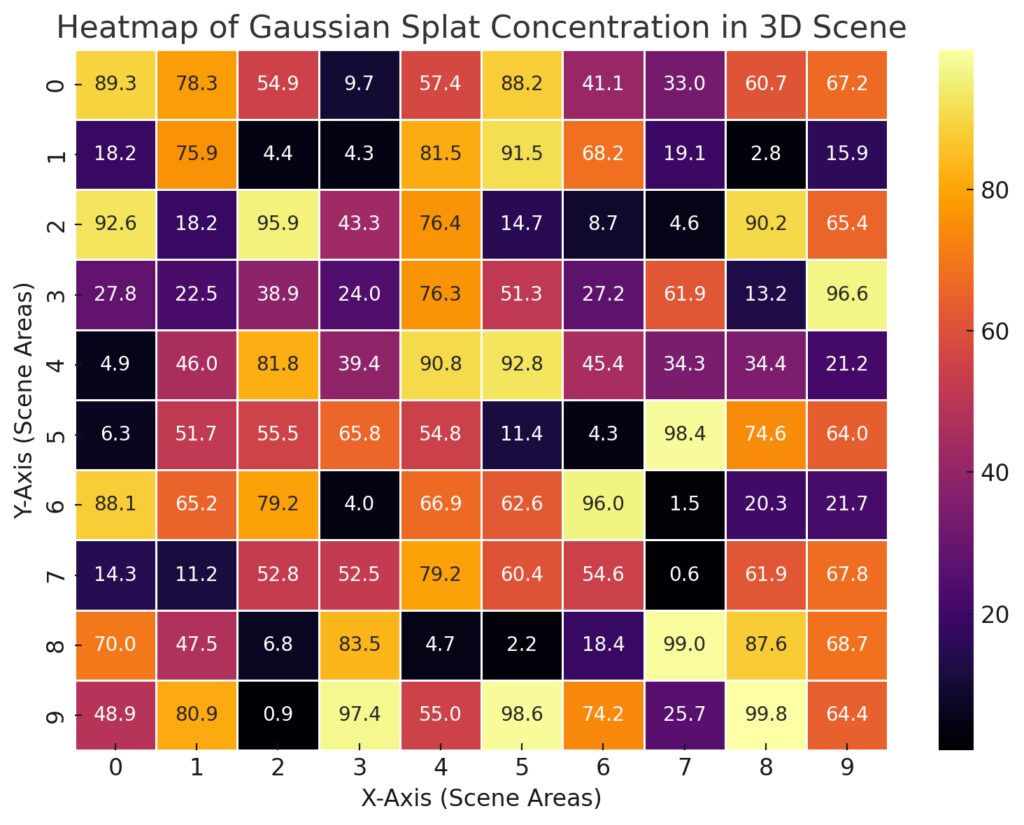
This makes it an ideal choice for everything from interactive training simulations to massive multiplayer online games (MMOs).
How AI is Learning to Create with 3D Gaussian Splatting
Artificial Intelligence (AI) is becoming a crucial player in the world of 3D rendering, and 3D Gaussian Splatting is giving AI new tools to work with. Traditionally, neural networks have been taught to create and manipulate 2D images, but with Gaussian splatting, AI can now generate and optimize 3D spaces much more efficiently.
This means that neural networks aren’t just replicating scenes from images—they’re learning to predict and build fully interactive environments based on probability distributions.
This opens up new possibilities for AI-generated content in a wide range of industries. For instance, in architecture, AI can use Gaussian splatting to visualize buildings or landscapes, making the design process faster and more flexible.
Instead of manually modeling every detail, AI can fill in the gaps, using splats to render materials, textures, and lighting in real-time. The AI learns from its previous renders, improving its ability to predict how a scene should look based on the available data.
Challenges in Adopting 3D Gaussian Splatting
While 3D Gaussian Splatting offers incredible potential, it’s not without its challenges. One of the key hurdles is the adoption of new workflows. Many 3D artists and developers are already familiar with traditional rendering techniques and NeRFs.
Switching to Gaussian splatting means learning new methods, understanding Gaussian math, and rethinking how they approach scene construction. Although the speed and efficiency gains are clear, there’s still a learning curve.
Another challenge lies in the hardware requirements. Although Gaussian splatting is faster, it still demands high-end processing power, especially for large-scale environments. Developers and artists may need to invest in more advanced GPUs or cloud computing services to take full advantage of this new technology.
However, as the technique becomes more popular, it’s likely that software optimizations will make it more accessible for a wider range of users.
Despite these challenges, the advantages far outweigh the drawbacks. Early adopters are finding ways to integrate Gaussian splatting into their pipelines, and as more open-source tools and libraries become available, the barriers to entry will continue to decrease.
The Future of Neural Rendering: What’s Next Beyond Splatting?
It’s clear that 3D Gaussian Splatting is pushing the boundaries of neural rendering, but what comes next? As with any emerging technology, innovation never stops. Researchers are already exploring ways to combine Gaussian splatting with other rendering techniques to improve both accuracy and performance even further. One area of focus is the integration of machine learning algorithms that can optimize splatting in real-time, reducing the amount of manual intervention required.
Additionally, the future may see advancements in how splats are represented. While Gaussian splats are efficient, researchers are experimenting with alternative ways to represent light and texture in a scene, potentially leading to even faster and more detailed rendering techniques.
There’s also interest in developing AI systems that can automatically generate splats based on simple inputs, such as sketches or rough 3D models, allowing creators to quickly prototype their ideas.
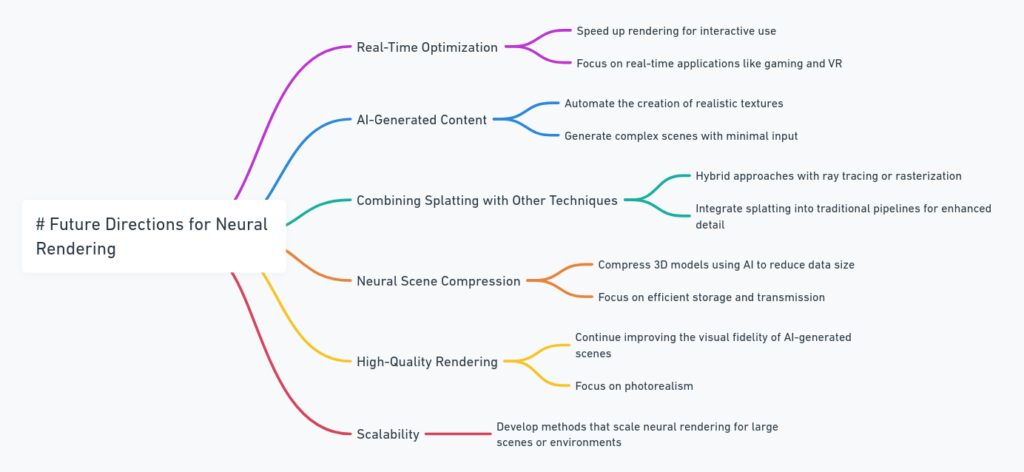
The possibilities are exciting, and it’s clear that neural rendering will continue to evolve at a rapid pace, with 3D Gaussian Splatting serving as a key stepping stone toward more immersive, realistic virtual environments.
How Developers Can Get Started with 3D Gaussian Splatting
For developers looking to dive into 3D Gaussian Splatting, the good news is that resources are becoming more available. Several open-source libraries and tools now exist that make it easier to experiment with splatting techniques. If you’re already familiar with NeRFs, you’ll find that Gaussian splatting builds on many of the same principles, but with a more streamlined approach to data representation.
Start by exploring tools that support Gaussian rendering, such as PyTorch3D, which offers a framework for working with 3D graphics in Python. You can also look into papers and tutorials from research institutions that are developing these technologies. As you get more comfortable with the theory, the practical applications will start to fall into place.
It’s also essential to stay up-to-date with developments in the neural rendering community. Conferences like SIGGRAPH often showcase cutting-edge techniques, and following these trends will give you insights into how to refine your workflows.
The Role of Open-Source Communities in Neural Rendering Innovation
Open-source communities have played a huge role in the advancement of neural rendering technologies, and they continue to push the envelope with 3D Gaussian Splatting. By sharing tools, code, and research papers, developers around the world are contributing to the rapid evolution of this field. Sites like GitHub are filled with repositories dedicated to neural rendering, with developers constantly experimenting, refining, and improving on each other’s work.
This spirit of collaboration has enabled faster adoption of new techniques and has made technologies like Gaussian Splatting more accessible to a broader range of creators. Even if you’re just getting started with neural rendering, you’ll find plenty of resources and communities eager to help you along the way.
With the right resources and a bit of curiosity, you’ll be well on your way to exploring the next frontier of 3D rendering.
This article explores how 3D Gaussian Splatting is reshaping neural rendering, creating opportunities in VR, gaming, and AI-driven creativity. It’s the next big step for developers looking to push the limits of real-time 3D environments. Dive in and discover the future of immersive virtual experiences!
Resources
Here are a few excellent resources for diving deeper into 3D Gaussian Splatting and neural rendering:
1. Research Papers
- “3D Gaussian Splatting for Real-Time Radiance Field Rendering”: This is the original research paper on 3D Gaussian Splatting, which introduces the concept and explores its advantages over NeRFs. The paper covers the mathematical foundation, rendering speed, and real-world applications. You can find it on platforms like arXiv here.
- “NeRF: Representing Scenes as Neural Radiance Fields for View Synthesis”: Understanding NeRFs is key to seeing how Gaussian Splatting improves upon existing techniques. This paper is a foundational text for those interested in neural rendering and can be accessed on arXiv here.
2. Open-Source Tools and Libraries
- PyTorch3D: This open-source library, provided by Facebook AI Research (FAIR), is an excellent tool for 3D deep learning. It supports volumetric rendering, including Gaussian splatting techniques, making it easier for developers to experiment with neural rendering. Check out the library on GitHub here.
- NVIDIA’s Instant NeRF: NVIDIA has made waves with its real-time NeRF implementation, a precursor to many splatting techniques. Their open-source model demonstrates how to optimize neural rendering for real-time applications. Visit NVIDIA’s developer blog here.
3. Tutorials and Educational Resources
- YouTube Tutorials on Gaussian Splatting: There are many tutorials popping up on platforms like YouTube, which break down the complex math behind Gaussian splatting and show real-world use cases. Searching for “Gaussian Splatting Neural Rendering” can guide you to valuable hands-on resources.
- SIGGRAPH Presentations: SIGGRAPH is the leading conference in computer graphics and interactive techniques. Many talks and presentations are freely available online, covering the latest advancements in neural rendering. Look out for their latest discussions on Gaussian Splatting and how it’s revolutionizing the field.
4. GitHub Repositories
- Gaussian Splatting Implementations: Developers are actively contributing to neural rendering advancements by publishing code implementations of the newest research. Searching GitHub for “3D Gaussian Splatting” will return projects where you can contribute or experiment.
5. Neural Rendering Communities
- Reddit Communities: Subreddits like r/NeuralRendering or r/ComputerGraphics are vibrant places for discussion, where developers and researchers share tips, resources, and troubleshooting advice. Great for staying up-to-date with the latest news.